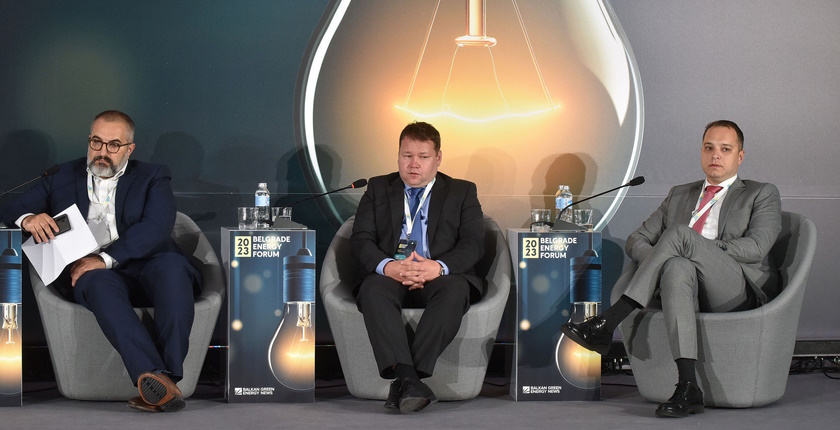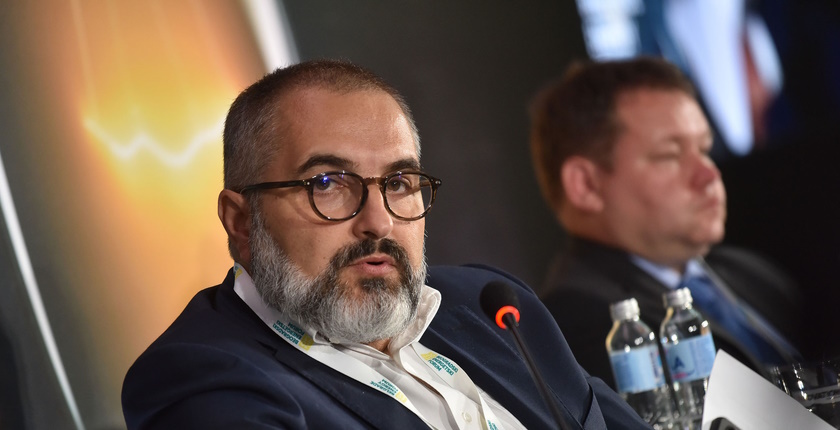
Photo: Balkan Green Energy News
Corporate power purchase agreements (PPAs) are slowly taking over the market as a model that combines the interests of producers, consumers, financiers, and traders, while the upcoming reform of the existing electricity market design in the European Union (EU) will give them an additional boost. Businesses in the region must quickly adapt to the new power purchase rules in order to maintain and improve their competitiveness, according to the panel Market design – is the current electricity market model sustainable?, which was held as part of Belgrade Energy Forum 2023.
The two-day Belgrade Energy Forum 2023 (BEF 2023) brought together representatives of governments, the energy sector, and major companies in Serbia’s capital city for discussions on the energy transition in Southeastern Europe. The biggest energy conference in the region was attended by four hundred participants from 28 countries, including representatives of international organizations.
High energy prices were due to EU’s dependence on fossil fuels

Dejan Stojčevski (SEEPEX), Christophe Gence-Creux (ACER) and Jasmina Trhulj (Energy Community)
The energy crisis forced almost all the governments around the world to take action in order to provide citizens and businesses with stable electricity supply at acceptable prices amid soaring electricity costs, which were rising at a pace five to ten times faster than before the onset of the crisis.
At the same time, many EU governments called for changing the basic principles of the energy market, because they saw them as the culprit for the rising prices.
However, Christophe Gence-Creux, head of the electricity department at the EU Agency for the Cooperation of Energy Regulators (ACER), believes that the basic principles of the electricity market in the EU have proven to be good and stable. Regulators and a good number of experts believe, he says, that short-term markets have functioned well, and that it is important to send clear price signals.
Whether we like it or not, those signals exposed the cost of Europe’s dependence on fossil fuels and Russian gas, Gence-Creux said, adding that they also showed the importance of flexible energy sources and a flexible market.
Gence-Creux: the EU wants to reform the market to reduce price volatility
Regulators and experts even believe that the existing integration of the EU market played the critical role in reducing the impacts of the energy crisis, and Gence-Creux cites three proofs for this, based on an analysis of what was happening: the benefit from cross-border trade was EUR 36 billion in 2022, price volatility would have been seven times more severe had it not been for cross-border trade, and France managed to secure enough electricity last winter, becoming an importer for the first time thanks to solidarity and cross-border trade.
However, they agreed that long-term markets and hedging options must be improved, which, said Gence-Creux, is the essence of the proposal to reform the EU market design. The main goal, according to him, is to tame prices and speed up the energy transition.
As for the response of EU governments, ACER’s analysis showed that they introduced as many as 400 different measures, one third of which was aimed at ensuring the security of supply and the rest at making energy prices acceptable to consumers.
Gence-Creux believes those measures will remain in place for some time, at least until the effects of the market reform are seen.
Stojčevski: energy independence is viewed differently by the EU and the region
According to the moderator of the panel, SEEPEX Chief Operating Officer Dejan Stojčevski, the crisis made energy independence relevant again, but the EU viewed it at the level of the entire bloc, while countries in the region saw it at the level of national borders.

Jasmina Trhulj, Energy Community
Nevertheless, said Jasmina Trhulj, Head of the Electricity Department at Energy Community, the region too maintained its security of supply through imports. Last year, it imported a total of some 2.8 TWh of electricity.
She recalled that the region has large cross-border trade capacities in interconnectors between countries, but that the utilization rate is at 20-30%. However, the EU’s target of 70% will soon become binding for the Energy Community contracting parties as part of a new package of electricity regulations, adopted by the Ministerial Council of the Energy Community in December 2022.
Trhulj: to ensure exemption from CBAM, countries in the region must carry out reforms
With the adoption of that package, the Energy Community contracting parties practically became full members of the EU when it comes to the electricity market, according to her. For the first time, there is reciprocity, meaning that the Energy Community contracting parties and the EU members are subject to the same requirements on the borders between the region and the bloc. For the first time, the integration of power markets has been formally and legally enabled, according to Trhulj.
Although the Energy Community contracting parties are some ten years behind the EU when it comes to market integration, Trhulj warns that they do not have much time because some things have to be done in the next two years.
The package includes regulations that are a prerequisite for market coupling, which, in turn, is a requirement for exemption from the EU’s Carbon Border Adjustment Mechanism (CBAM). The carbon border tax takes effect in 2026, and market coupling has to be completed by then, she explained.
PPAs are available in region and seen as right solution under EU market reform

Vladimir Đorđević (Axpo), Anže Predovnik (BSP SouthPool, ADEX Group), Matija Medojević (BELEN)
The EU’s proposal for the power market reform is on the table, and Christophe Gence-Creux expects it to be adopted by the end of the year. The focus, he says, is on two things.
The first is to increase the liquidity of the long-term market and the use of hedging instruments. There are at least four measures to achieve this: giving consumers the option to sign long-term contracts at fixed prices, enabling them to sign contracts with multiple suppliers and combine physical and financial contracts, removing obstacles to signing PPAs, and promoting contracts for difference (CfD).
Gence-Creux: there is a danger that each EU member will start looking only after itself
The other focus is on flexibility. The proposal is to impose the obligation on EU members to assess the needs for flexibility for the next ten years, so that measures can be taken to meet those needs. The plan is also to reduce obstacles to applying and implementing demand response programs and rules for demand response, as well as subsidies for flexibility in case the market fails to deliver it on its own.
Gence-Creux also believes that the reform carries the risk that EU members can make a mistake by looking only after themselves, due to the fact that the energy transition is difficult, challenging and expensive for end consumers. The energy crisis, he added, confirmed this, but also showed that the energy transition must be accelerated.
If the energy transition is to be implemented at acceptable costs, then it must be carried out jointly, he said. Market integration is an opportunity that must be seized. It is an insurance policy for bad decisions at the national level, such as Germany’s reliance on natural gas or France’s technical problems at nuclear power plants, according to Gence-Creux.
When it comes to consumers, especially businesses, the energy crisis was a wake-up call, showing them they have to change the way they procure electricity.
According to Dejan Stojčevski, the changes initiated by the energy transition have only been accelerated, and one of the solutions to the problems is PPAs, which are also available in the region.
Đorđević: PPAs will be the cornerstone of long-term energy supply contracting
However, he said, it is necessary for large business consumers to make a little more effort, educate themselves, and eventually join the power market.

Vladimir Đorđević, Axpo
Swiss company Axpo was part of the first corporate PPA in Serbia, which was concluded for the Krivača wind farm.
AXPO’s Vladimir Đorđević says that market participants in the region are interested in PPAs. Large corporations see PPAs as a way to ensure a long-term price and achieve corporate social responsibility goals, but there are also a large number of owners of new power plant projects and financiers who are ready to invest. However, what was missing was a link to the market, especially the long-term market, which was not liquid.
This is the reason why Axpo is trying to introduce new power purchase and hedging models in the region and to promote PPAs, which, the company believes, will be the cornerstone of contracting and securing energy supplies over longer periods.
Axpo has so far contracted more than 900 MW of projects, securing electricity it can offer to customers through PPAs, said Đorđević.
Axpo has contracts for power plants with a total capacity of 900 MW
Regardless of the market reforms, it is already possible to conclude PPAs in the region, although the procedure is complicated, according to him.
He recalled that there are two types of corporate PPAs: physical, where firms like Axpo connect producers and consumers and provide balancing, and virtual, or financial, where the producer enters into a financial contract to secure a fixed price, and possibly financing, and a firm such as Axpo provides physical supply to consumers in the local market.
These are solutions that offer consumers the opportunity to ensure a fixed price, predictable costs, and cheaper energy, as well as to meet the goals of the green agenda, said Đorđević.
If regulators want to facilitate the signing of PPAs, they should first establish functional balancing and system services markets, but also enable industrial consumers to conclude contracts with multiple suppliers.
Four new power exchanges in the region

Matija Medojević, BELEN
Given that electricity exchanges are a prerequisite for developing new electricity sale and purchase models and attracting investments, there has been some good news in recent weeks. After a seven-year hiatus, Dejan Stojčevski said, the region got three power exchanges in a short period of time: in Albania, Montenegro, and North Macedonia. On top of that, a merger between Slovenia’s BSP SouthPool and Serbia’s SEEPEX created a regional power exchange, Adex.
Anže Predovnik, Director of BSP SouthPool, said that the new platform represents consolidation, initially between the two stock exchanges, but with the intention of continuing the process at the regional level. He announced that the first result will be an intraday market on SEEPEX, which will be launched by the end of the summer.
Predovnik recalled that the power exchanges in the region did their part in the energy crisis, but that the challenges were great. Average prices in the first half of 2021 were around EUR 61 per MWh, but they rose to as high as EUR 281 in the second half of 2022, and then fell to EUR 127 in the first quarter of this year.
Montenegro is expected to decide on whether to pursue market coupling with Italy or with Serbia
Matija Medojević, Director of the Montenegrin Power Exchange (BELEN), said that the launch of the exchange with 15 participants showed that Montenegro has potential when it comes to electricity trade.
“We expect the exchange to facilitate the integration of renewable sources, to encourage existing producers to enter the market, as well as to attract new investments,” he said.
Medojević noted that the exchange is not an end in itself, but a step towards further integration, which is already being considered, along with ways to improve liquidity.
The plan is to merge the Montenegrin market with another market, which implies two things – adopting regulations and taking a strategic, political position on whether to do it with Serbia or with Italy. It is also possible that the Energy Community will propose a third way, according to Medojević.


















Be the first one to comment on this article.